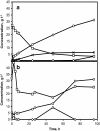Simultaneous saccharification and co-fermentation for bioethanol production using corncobs at lab, PDU and demo scales
- PMID: 23311728
- PMCID: PMC3598390
- DOI: 10.1186/1754-6834-6-2
Simultaneous saccharification and co-fermentation for bioethanol production using corncobs at lab, PDU and demo scales
Abstract
Background: While simultaneous saccharification and co-fermentation (SSCF) is considered to be a promising process for bioconversion of lignocellulosic materials to ethanol, there are still relatively little demo-plant data and operating experiences reported in the literature. In the current work, we designed a SSCF process and scaled up from lab to demo scale reaching 4% (w/v) ethanol using xylose rich corncobs.
Results: Seven different recombinant xylose utilizing Saccharomyces cerevisiae strains were evaluated for their fermentation performance in hydrolysates of steam pretreated corncobs. Two strains, RHD-15 and KE6-12 with highest ethanol yield and lowest xylitol yield, respectively were further screened in SSCF using the whole slurry from pretreatment. Similar ethanol yields were reached with both strains, however, KE6-12 was chosen as the preferred strain since it produced 26% lower xylitol from consumed xylose compared to RHD-15. Model SSCF experiments with glucose or hydrolysate feed in combination with prefermentation resulted in 79% of xylose consumption and more than 75% of the theoretical ethanol yield on available glucose and xylose in lab and PDU scales. The results suggest that for an efficient xylose conversion to ethanol controlled release of glucose from enzymatic hydrolysis and low levels of glucose concentration must be maintained throughout the SSCF. Fed-batch SSCF in PDU with addition of enzymes at three different time points facilitated controlled release of glucose and hence co-consumption of glucose and xylose was observed yielding 76% of the theoretical ethanol yield on available glucose and xylose at 7.9% water insoluble solids (WIS). With a fed-batch SSCF in combination with prefermentation and a feed of substrate and enzymes 47 and 40 g l-1 of ethanol corresponding to 68% and 58% of the theoretical ethanol yield on available glucose and xylose were produced at 10.5% WIS in PDU and demo scale, respectively. The strain KE6-12 was able to completely consume xylose within 76 h during the fermentation of hydrolysate in a 10 m3 demo scale bioreactor.
Conclusions: The potential of SSCF is improved in combination with prefermentation and a feed of substrate and enzymes. It was possible to successfully reproduce the fed-batch SSCF at demo scale producing 4% (w/v) ethanol which is the minimum economical requirement for efficient lignocellulosic bioethanol production process.
Figures






Similar articles
-
Model-based optimization and scale-up of multi-feed simultaneous saccharification and co-fermentation of steam pre-treated lignocellulose enables high gravity ethanol production.Biotechnol Biofuels. 2016 Apr 18;9:88. doi: 10.1186/s13068-016-0500-7. eCollection 2016. Biotechnol Biofuels. 2016. PMID: 27096006 Free PMC article.
-
Process design of SSCF for ethanol production from steam-pretreated, acetic-acid-impregnated wheat straw.Biotechnol Biofuels. 2016 Oct 18;9:222. doi: 10.1186/s13068-016-0635-6. eCollection 2016. Biotechnol Biofuels. 2016. PMID: 27777624 Free PMC article.
-
Steam pretreatment and fermentation of the straw material "Paja Brava" using simultaneous saccharification and co-fermentation.J Biosci Bioeng. 2011 Feb;111(2):167-74. doi: 10.1016/j.jbiosc.2010.10.009. Epub 2010 Nov 16. J Biosci Bioeng. 2011. PMID: 21081285
-
Improving simultaneous saccharification and co-fermentation of pretreated wheat straw using both enzyme and substrate feeding.Biotechnol Biofuels. 2010 Aug 2;3:17. doi: 10.1186/1754-6834-3-17. Biotechnol Biofuels. 2010. PMID: 20678195 Free PMC article.
-
Bioconversion of Crop Residues Using Alternative Fermentation-Based Approaches.Front Biosci (Elite Ed). 2023 Jul 7;15(3):17. doi: 10.31083/j.fbe1503017. Front Biosci (Elite Ed). 2023. PMID: 37743232 Review.
Cited by
-
Adapted feeding strategies in fed-batch fermentation improve sugar delivery and ethanol productivity.Bioengineered. 2023 Dec;14(1):2250950. doi: 10.1080/21655979.2023.2250950. Bioengineered. 2023. PMID: 37655550 Free PMC article.
-
Influence of the propagation strategy for obtaining robust Saccharomyces cerevisiae cells that efficiently co-ferment xylose and glucose in lignocellulosic hydrolysates.Microb Biotechnol. 2015 Nov;8(6):999-1005. doi: 10.1111/1751-7915.12280. Epub 2015 May 18. Microb Biotechnol. 2015. PMID: 25989314 Free PMC article.
-
Ethanol Production from Oil Palm Trunk: A Combined Strategy Using an Effective Pretreatment and Simultaneous Saccharification and Cofermentation.Int J Microbiol. 2021 Dec 23;2021:2509443. doi: 10.1155/2021/2509443. eCollection 2021. Int J Microbiol. 2021. PMID: 34976067 Free PMC article.
-
Combined substrate, enzyme and yeast feed in simultaneous saccharification and fermentation allow bioethanol production from pretreated spruce biomass at high solids loadings.Biotechnol Biofuels. 2014 Apr 8;7(1):54. doi: 10.1186/1754-6834-7-54. Biotechnol Biofuels. 2014. PMID: 24713027 Free PMC article.
-
SSF of steam-pretreated wheat straw with the addition of saccharified or fermented wheat meal in integrated bioethanol production.Biotechnol Biofuels. 2013 Nov 29;6(1):169. doi: 10.1186/1754-6834-6-169. Biotechnol Biofuels. 2013. PMID: 24286350 Free PMC article.
References
-
- GlobalBP. BP Statistical review of world energy June 2011. 2011. http://www.bp.com/statisticalreview
-
- Bidlack J, Malone M, Benson R. Molecular structure and component integration of secondary cell walls in plants. Proceedings of the Oklahoma Academy of Science. 1992;72:51–56.
LinkOut - more resources
Full Text Sources
Other Literature Sources
Molecular Biology Databases
Miscellaneous

